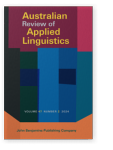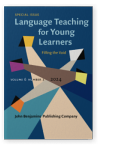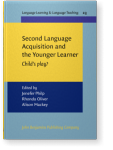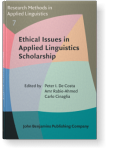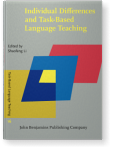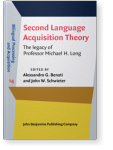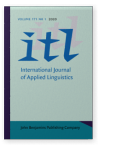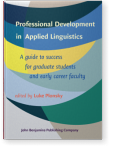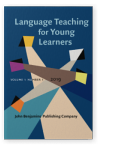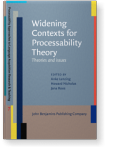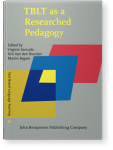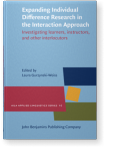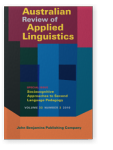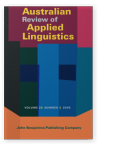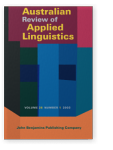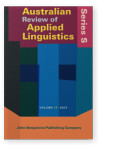Rhonda Oliver
List of John Benjamins publications for which Rhonda Oliver plays a role.
Journals
ISSN 2589-2053 | E-ISSN 2589-207X
Title
Second Language Acquisition and the Younger Learner: Child's play?
Edited by Jenefer Philp, Rhonda Oliver and Alison Mackey
[Language Learning & Language Teaching, 23] 2008. viii, 334 pp.
Subjects Applied linguistics | Language acquisition | Language teaching | Multilingualism
2024 Chapter 11. “Where you from, who’s your Mob?”: Ethical considerations when undertaking Australian Aboriginal and Torres Strait Islander applied linguistic research Ethical Issues in Applied Linguistics Scholarship, De Costa, Peter I., Amr Rabie-Ahmed and Carlo Cinaglia (eds.), pp. 192–209 | Chapter
In this chapter, we discuss how “yarning” — a traditional way of communicating, making and sharing meaning within Aboriginal society — may work as a research paradigm and methodology for qualitative ethnographic studies in applied linguistics. Yarning involves story telling as part of… read more
2024 Chapter 9. Task-based language learning and teaching: Differences according to age Individual Differences and Task-Based Language Teaching, Li, Shaofeng (ed.), pp. 262–286 | Chapter
Different theoretical perspectives have informed task-based research exploring variables related to individual differences. Whilst the majority of studies have been undertaken with adult learners, there is a small and growing body of work investigating what younger learners do when they use… read more
2022 Chapter 12. A task-based needs analysis framework for TBLT: Theory, purpose, and application Second Language Acquisition Theory: The legacy of Professor Michael H. Long, Benati, Alessandro G. and John W. Schwieter (eds.), pp. 235–256 | Chapter
This chapter focuses on the evidenced-based Task Based Needs Analysis (NA) model that Michael Long developed as a tool for Task Based Language Teaching (TBLT). It describes the theoretical underpinnings of the model, its purpose and aims, its function in TBLT, how it contributes to task and… read more
2020 The effect of task repetition on the patterns of interaction of ESL children ITL - International Journal of Applied Linguistics 171:1, pp. 90–112 | Article
Research on collaborative work has explored the benefits of task repetition (TR) for L2 development. TR has been claimed to improve L2 complexity, accuracy and fluency, provide opportunities for feedback, and increase learners’ engagement in their L2, as reported in studies that have explored… read more
2020 Chapter 5. Towards achieving work-life balance in academia: Comments and personal essays from six applied linguists Professional Development in Applied Linguistics: A guide to success for graduate students and early career faculty, Plonsky, Luke (ed.), pp. 49–64 | Chapter
The competing demands of teaching, research, and service seem to never end. Consequently, as academics, we often find ourselves feeling unable to realize our professional goals while also maintaining a life outside of work. Recognizing that there is no one-size-fits-all way to achieve or… read more
2019 Patterns of interaction and young ESL learners: What is the impact of proficiency and task type? Language Teaching for Young Learners 1:1, pp. 82–102 | Article
Previous research carried out from a socio-cultural perspective has explored the way adult learners interact when undertaking tasks. Following the type of analysis initiated by Storch (2002) we examined the patterns of interaction of young ESL learners (ages 9–12) of different English… read more
2019 Chapter 15. Can print literacy impact upon learning to speak Standard Australian English? Widening Contexts for Processability Theory: Theories and issues, Lenzing, Anke, Howard Nicholas and Jana Roos (eds.), pp. 349–370 | Chapter
Second language learning research mostly investigates literate learners. Based on studies by Tarone, Bigelow and colleagues (2004, 2005, 2006, 2006) this small scale study focuses on low level literacy learners who are acquiring Standard Australian English as their second dialect. It explores… read more
2018 Chapter 3. Teacher perceptions and use of tasks in school ESL classrooms TBLT as a Researched Pedagogy, Samuda, Virginia, Kris Van den Branden and Martin Bygate (eds.), pp. 71–96 | Chapter
Although Task-Based Language Teaching (TBLT) is becoming increasingly popular among researchers and practitioners worldwide, teachers’ perceptions about tasks and their use within school classrooms have received scant attention in the literature. Given that perceptions about ‘task’ influence… read more
2017 Chapter 8. Vietnamese TESOL teachers’ cognitions and practices: Developing learner-centered learning Expanding Individual Difference Research in the Interaction Approach: Investigating learners, instructors, and other interlocutors, Gurzynski-Weiss, Laura (ed.), pp. 173–199 | Chapter
Due to its historical and socio-cultural context, the traditional way of teaching and learning in Vietnam follows Confucian traditions and is characterized by teacher-centeredness and passive student learning. To develop learner autonomy and promote the development of communicative competence,… read more
2011 Teacher awareness and understandings about Aboriginal English in Western Australia Australian Review of Applied Linguistics 34:1, pp. 60–74 | Article
Repeated assessments of literacy skills have shown that Aboriginal students do not achieve at the same level as their non-Aboriginal peers. Many Aboriginal students speak Aboriginal English, a dialect different from the Standard Australian English used in schools. Research shows that it is crucial… read more
2010 The provision and uptake of different types of recasts in child and adult ESL learners: What is the role of age and context? Sociocognitive Approaches to Second Language Pedagogy, Dyson, Bronwen Patricia (ed.), pp. 26.1–26.22 | Article
The role of conversational interaction in second language research has increasingly been seen as playing a facilitative role in second language learning. As such there have been a number of studies focussing on different types of interaction, including feedback such as recasts, and their potential… read more
2010 Rehearsing, conversing, working it out: Second language use in peer interaction Sociocognitive Approaches to Second Language Pedagogy, Dyson, Bronwen Patricia (ed.), pp. 28.1–28.25 | Article
This paper reports on a study of peer interaction in ten foreign language (FL) classes, six secondary and four primary, over a period of four months. The focus of this paper is the nature of peer interaction, including the purposes of second language use, and language choice. The data, comprising… read more
2008 The impact of teacher input, guidance and feedback on ESL children's task-based interactions Second Language Acquisition and the Younger Learner: Child's play?, Philp, Jenefer, Rhonda Oliver and Alison Mackey (eds.), pp. 131–147 | Article
In this chapter we examine children’s interaction during authentic lessons involving tasks in L2 classrooms, comparing the effects of teacher guidance for 5–7 year olds (n = 22) and 11–12 year olds (n = 20). Three experimental conditions representing a continuum of teacher guidance were examined:… read more
2008 Child's play? Second language acquisition and the younger learner in context Second Language Acquisition and the Younger Learner: Child's play?, Philp, Jenefer, Rhonda Oliver and Alison Mackey (eds.), pp. 3–23 | Article
2005 Teacher perceptions of student speech: A quantitative study Australian Review of Applied Linguistics 28:2, pp. 44–59 | Article
This study reports on teachers’ attitudes towards their students’ speech varieties of English. A sample of 172 primary, district high and secondary teachers in Western Australian schools was surveyed on their attitudes towards language variation and towards their students’ use of specific English… read more
2003 Is it a case of mind over matter? Influences on teachers’ judgements of student speech Australian Review of Applied Linguistics 26:1, pp. 55–70 | Article
Although language variation is widespread and natural, it is subject to judgement. Where a standard language has developed, other varieties tend to be judged against its ‘standard’. While a number of overseas studies have found that this type of linguistic bias occurs in education and negatively… read more
2003 Chat-Line interaction and negative feedback Asian Languages and Computers, Hoven, Debra and Jeong-Bae Son (eds.), pp. 60–73 | Article
In recent years researchers have investigated the use of Internet applications for language and cultural learning. While this new technology seems to have provided an educational breakthrough, relatively little linguistic research has been conducted particularly in relation to second language… read more
